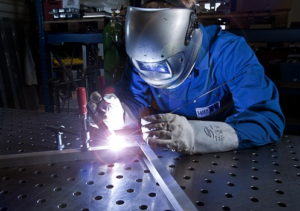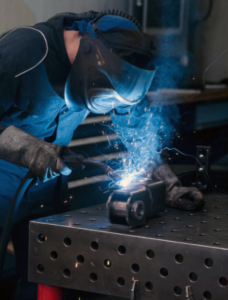The choice between welding with inert gases such as nitrogen, argon or helium (MIG welding) or with active gases such as CO2 (MAG welding) is made based on the materials to be welded. Precious metals such as stainless steel, aluminum, copper, or titanium should be welded with inert gases. Here, the gas cannot react with the weld metal, protecting the welding process.
An active gas such as CO2 takes part in the reaction and thus influences the final result. This is desirable in some cases, such as welding of alloyed or non-alloyed steel, where the CO2 used in MAG welding has a stabilizing effect on the arc.
What is WIG/TIG welding?
Unlike MIG welding, TIG/TIG welding uses an electrode made of wolfram, which does not melt during welding due to its high melting point. Filler material is therefore added with an additional wire. Compared to MIG welding, TIG welding is more precise and controlled.
Shielding gases or gas mixtures that influence the reaction can also be used, but this would then be WAG/TAG welding. For example, a small amount of oxygen can improve the quality of the welds.
Advantages of gas shielded welding methods
MIG/MAG and TIG/TIG welding can be used as desired when welding by hand or when automated by robots. For this purpose, it can join almost all materials suitable for welding, including materials of different thickness and composition.
- MIG/MAG welding is very versatile in its application
- It can be performed manually or automatically
- TIG-TIG welding is fast, efficient and yields strong and very clean welds
- It is also excellent for welding thin metal and sheet metal parts
At Prostor Design, we use both MIG/MAG and TIG/TIG methods to weld various materials such as aluminum, carbon and stainless steel.
If you are interested in how we can assist you with your project, please feel free to contact us!

 +420 388 314 321
+420 388 314 321  obchod@prostor-design.cz
obchod@prostor-design.cz 



